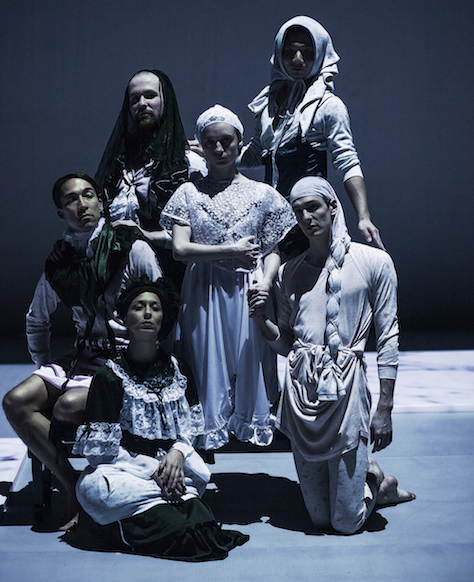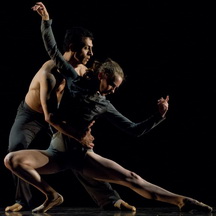
At the beginning of the performance the choreographer Trajal Harrell announces that what will be presented is not The Ghost of Montpellier Meets the Samurai as announced in the Cal Performances program. Rather something called something like Cannes Amour, Harrell’s French pronunciation leaves the title doubtful. This surprise played on the audience is a device used throughout the ensuing performance.
Three times we are introduced to work, “And now, ladies and gentlemen, The Ghost of Montpellier Meets the Samurai!” OK, possibly they didn’t say “ladies and gentlemen,” but the circus barker/illusionist motif was so strong that they might have and the effect would have been the same. For that is what Harrell’s performance recalls in its wry and idiosyncratic way: performance’s alliance with illusion, an effect created and maintained by fooling the audience, presenting something that is smoke and mirrors.
In Harrell’s work, though, the smoke and mirrors are not based on the convincing magic of theater: the portrayal of realities into which the viewer is swept, willing to suspend disbelief, willing to believe the portrayal is reality. The smoke and mirrors in Harrell’s work are in the performers’ attempts to convince the viewer that the mocking, playful, low-key theater they present is somehow as meaningful as the work it refers to. At its best it’s amusing; at its worst pretentious in a tired sort of way.
The title and the concept are about the meeting of two choreographers and the melding of their very different and personal dance forms. The Ghost in the title refers to French choreographer Dominique Bagouet, who set up the Centre Choreographique Languedoc-Roussillon at Montpellierin 1980, and died of AIDS at the age of 41. A ballet-trained dancer Bagouet had restlessly travelled through a wide range of movement techniques, enamored as a child to flamenco, studying with American ballerina Rosella Hightower and the dramatic radical choreographer Bejart, performing with Trisha Brown, among many others. His choreography is personal and formal, theatrical and various.
The Samurai is Tatsumi Hijikata, the founder of butoh, who died of cancer in 1986, at the age of 57. Hijikata first called his dance form Ankoku Butoh, or “ancient dance step of utter darkness.” Butoh is theater dance, with an emphasis on theater or that odd beast, performance art, heavily resistant to traditional dance, both Eastern and Western, but with an abiding connection to the tenets of ephemerality that are essential to Japanese aesthetics. Western expressionist modern dance was also fundamental to the choreographer’s sense of movement.
I mention the deaths of both these men because they are central to Harrell’s piece. As dancers Christina Vassilou and Thibault Lac narrate to the audience, the piece is based on an imaginary meeting between Bagouet and Hijikata, in which they decide to choreograph two pieces: one by Bagouet imagining himself as Hijikata and one by Hijikata imagining himself as Bagouet. There is lengthy discussion and contradiction as to when the event took place, along with where, how and what, which cannot be confirmed because of the deaths of these two men.
The discussion sets up a thought experiment. A series of hypothetical what-ifs.
Harrell used this device previously in his work Twenty Looks or Paris Is Burning at The Judson Church, which used the collision of postmodern dance with voguing as the collision. The thought experiment is derailed, however, and instead morphs into a long dance-ish piece based on the runway. In which the dancers, who finally get to show a little bit of their dance chops, strut and pose on a long table and a set of benches that provide a catwalk for their voguing, including a long impressive solo by Lac. Wearing generic clothes in all manner of wrappings, layerings and stuffings, wearing more clothes in idiosyncratic ways (is that a sweater arm he’s stuck his well-muscled leg through?), shedding clothes, painting each other’s faces with white cream, here and there. A veritable barrage of child play.
Somewhere in the midst of Harrell’s whimsical ramblings the other choreographers and their work vanished. They were less than ghosts. Were they meant to be there at all, really?
– Jaime Robles
Photo: The Trajal Harrell dancers in The Ghost of Monpellier Meets the Samurai. Photo by Orpheas Emirzas.
